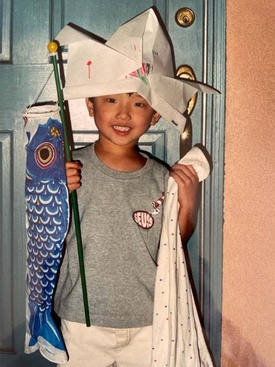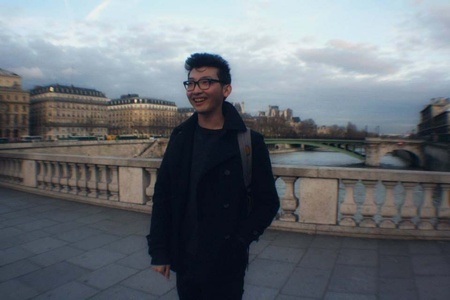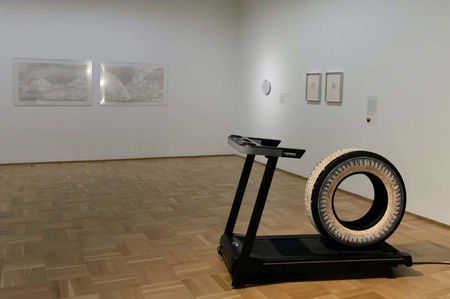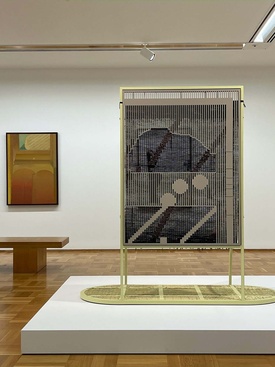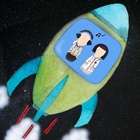While his life and work can be traced from Los Angeles to Paris then on to contemporary art museums and art galleries, the one consistent throughline for Nolan Jimbo is his connection to the Japanese American community.
A Japanese American Childhood in Los Angeles
Selected one of the 30 Changemakers Under 30 to celebrate JANM’s 30th anniversary in 2022, Jimbo grew up in the Silverlake neighborhood of Los Angeles playing Japanese American basketball for the Hollywood Dodgers, spending summers at local Obon festivals, and participating in Japanese American youth organizations such as Rising Stars. He ran in the JACCC’s Chibi-K and his name, along with his sister’s, is engraved on JANM’s Children’s Courtyard.
Jimbo’s education started at Lumbini Preschool at Higashi Hongwanji in Little Tokyo and from there he attended private schools: his elementary grades at Pilgrim School and St. James Episcopal School in mid-city Los Angeles with diverse student bodies, followed by Flintridge Preparatory School in La Canada with a majority white enrollment. His ability and confidence to build relationships with a broad group of friends grew.
“It was a complicated time. I was learning about my identity and learning how to function in a white world,” he said. “I enrolled at Tufts University thinking I had the tools to navigate almost any space.”
It was at Tufts in Boston, MA, where he realized he missed and needed his community.
“At that time, I thought a sign of independence was not needing a Japanese American community,” he said recalling his first weeks on campus. “No one was more surprised than me that I found a home with the Japanese Culture Club.” He met a wide spectrum of students: Japanese, Shin-Issei, and Japanese American. While their experiences were different and nuanced, they became close friends as they promoted Japanese and Japanese American culture on campus. “Joining this group was a real lesson in realizing how important the community is to me,” he said.
Exploring a Career in the Arts
He and his family are avid museum visitors, and Jimbo’s interest in art history was first sparked by a high school teacher. “I am a very visual person, but knew I didn’t have the technical skills to be an artist or designer,” explained Jimbo, who is also a strong writer interested in history, language and the humanities. “Art history was perfect for me.”
During his college years, he was selected to participate in the Getty Multicultural Undergraduate Internship program (now the Getty Marrow Undergraduate Internship program). For three summers he worked at Southern California museums: the USC Pacific Asia Museum, J. Paul Getty Museum, and Hammer Museum. The internships spanned a range of departments from curatorial to fundraising, and were a significant influence on his choice of career. Yet one key aspect of his internship experience did not go unnoticed. “All of my supervisors were white, so clearly there was a need for a multicultural program for students interested in the arts.”
In an extremely competitive field, Jimbo has garnered an impressive range of experiences in both the nonprofit and commercial art world. He spent his junior year in Paris interning at the Terra Foundation for American Art; immediately after graduating from Tufts, he spent a year working in the Contemporary Art Department at the Dallas Museum of Art, where he contributed to 11 exhibitions and 40 acquisitions.
Back in LA, he worked in communications at David Kordansky Gallery for two and a half years, before being accepted into the prestigious Williams Graduate Program in the History of Art. His class was comprised of 12 students.
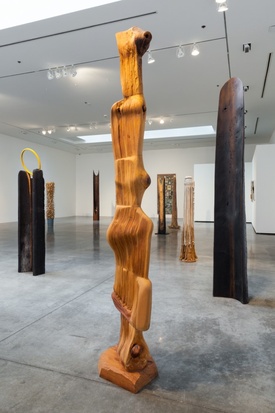
It was a few months before his departure for Williams in 2019 that he viewed Kenzi Shiokava’s exhibition at Otis College of Art and Design and felt an unexpected kinship.
Shiokava, who died at age 83 in June 2021, was a Japanese Brazilian artist living in South Los Angeles who worked as a gardener for decades. He graduated from Chouinard (now CalArts) and received an MFA from Otis. He was awarded the Public Recognition Award (determined by public vote) during the 2016 Made in LA Biennial at the Hammer Museum and his work was featured in JANM’s Transpacific Borderlands: The Art of Japanese Diaspora in Lima, Los Angeles, Mexico City and São Paolo exhibition, part of Pacific Standard Time: LA/LA in September 2017.
Shiokava’s art is composed of assembled materials – disparate elements, often everyday objects. Jimbo spent hours in the galleries. “Kenzi’s art is composed of materials that don’t belong together, and that felt like a reflection of my experience, of how I’ve assembled myself over the years.”
Jimbo found himself leaving the exhibition changed. Looking back now he says, “This is the show I didn’t see as a kid. And this is why I do this work, because I know that it can make a difference.”
Focusing on Asian American Artists
As a graduate student at Williams, he chose to focus on Asian American artists. Without an advisor with expertise in that area, Jimbo dedicated himself to unearthing historical Asian American artists for the purpose of creating a lineage with the contemporary Asian American artists of his generation. He was also selected as the Graduate Curatorial Fellow at MASS MoCA in nearby North Adams, MA.
His master's thesis brought him back to Shiokava. In “Woodwork, Waiting: Kenzi Shiokava and the Labor of Assemblage,” Nolan’s thesis explored how Shiokava’s life and work revealed that the Japanese American experience is intertwined with the history of Latinx and Black communities in Los Angeles; it also situated the artist’s sculptural practice within the rich history of Japanese American farming and gardening, drawing parallels between the labor of gardening and the labor of artmaking.
But it is his work organizing art exhibitions that allows him to identify the artwork of often unknown artists, research and write about them, and share their work with the public.
“With the exception of Isamu Noguchi and Ruth Asawa, there are very few works by Japanese American artists in museum collections. I want to see museums collect and preserve art by older Asian American and Asian diasporic artists before their work is lost forever.”

At MASS MoCA he organized Close to You, a group exhibition unified by a theme of queer kinship featuring artists of color, many identifying as queer or women. It opened in April 2021 and, at age 27, his exhibition was reviewed in the New York Times.
At the Museum of Contemporary Art (MCA) Chicago, where he is the Marjorie Susman Curatorial Fellow, he curated Chicago Works: Gregory Bae, the first solo show by the Korean American artist who died in July 2021. The show was reviewed by Artforum, an international magazine focused on contemporary art. In Sarah Thomson’s documentary book Seven Days in the Art World she writes, “Artforum is to art what Vogue magazine is to fashion...It’s a trade magazine with crossover cachet and an institution with controversial clout.” Jimbo visited 25 Chicago artist studios and spoke to many in the local Chicago art community before selecting Bae. Bae’s work is not yet in the collection of an art museum.
His third exhibition is inspired by art in the MCA Chicago’s collection, and an example of what’s possible when a museum collection includes work by Asian American artists. Researching the collection, he found the paintings of two Japanese American artists. Miyoko Ito was born in Berkeley and incarcerated in the Topaz, UT American concentration camp during World War II before settling in Hyde Park; Ray Yoshida is Kapa’a, Hawaii-born and taught at the School of the Art Institute of Chicago. The Nisei artists were active in the Chicago art scene from the 1960s until their respective deaths—Ito in 1983 and Yoshida in 2009. “Their work has been in the MCA's collection for decades without ever being shown,” said Jimbo, who set out to change that.

Interiors opened in July 2022 and at its center is Miyoko Ito’s painting Chiffonier, 1971. It also features Ray Yoshida’s Untitled (Rust Background), 1973-74. Instead of depicting portraits of individuals or family scenes, the art featured in the show are geometric abstractions, a form of art that relies on simplified shapes. “Abstract art interests me. It’s so open ended and has the capacity to be more flexible, more fluid. It has more nuance in articulating an idea,” said Jimbo. Abstract art has the ability “to reflect the feeling of straddling two worlds, it has the ability to convey movement and change.”
Caring for the Work of Asian American Artists
While Ito and Yoshida are well-known figures within Chicago, Interiors aims to place their work into a broader national and international context by showing their paintings alongside the work of others working in abstraction. By doing so, Jimbo hopes to advocate for Ito and Yoshida’s place within a global art history.
“Within art museums across the United States, the work of Japanese American, and more broadly, Asian American artists has historically been neglected and continues to be so today,” said Jimbo.
In an art world that has long prioritized white male artists, Jimbo is committed to placing artworks by Asian American and Asian diasporic artists in museum collections. While this work is slow, incremental, and largely invisible to the public, it’s what will best ensure that the legacies of these artists are valued, cared for, and available to those documenting a more comprehensive history. “By focusing on the collaborative work between artists, collectors, curators, and scholars, we can elevate Asian American artists and their place in the canon of art history. Years from now, others doing research will be able to access these objects and develop new scholarship about our history.”

© 2022 Carol Komatsuka



